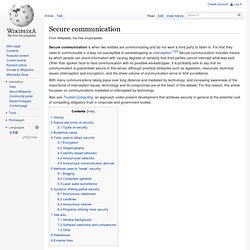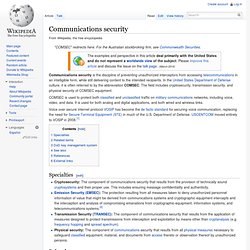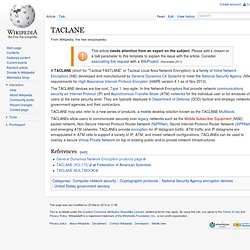

Secure communication. Secure communication is when two entities are communicating and do not want a third party to listen in.

For that they need to communicate in a way not susceptible to eavesdropping or interception.[1][2] Secure communication includes means by which people can share information with varying degrees of certainty that third parties cannot intercept what was said. Other than spoken face-to-face communication with no possible eavesdropper, it is probably safe to say that no communication is guaranteed secure in this sense, although practical obstacles such as legislation, resources, technical issues (interception and encryption), and the sheer volume of communication serve to limit surveillance. With many communications taking place over long distance and mediated by technology, and increasing awareness of the importance of interception issues, technology and its compromise are at the heart of this debate. History[edit] Nature and limits of security[edit] Types of security[edit] Encryption[edit]
Information warfare. The United States Military focus tends to favor technology, and hence tends to extend into the realms of Electronic Warfare, Cyber Warfare, Information Assurance and Computer Network Operations / Attack / Defense.

Most of the rest of the world use the much broader term of "Information Operations" which, although making use of technology, focuses on the more human-related aspects of information use, including (amongst many others) social network analysis, decision analysis and the human aspects of Command and Control. Overview[edit] Information warfare can take many forms: Television and radio transmission(s) can be jammed.Television and radio transmission(s) can be hijacked for a disinformation campaign.Logistics networks can be disabled.Enemy communications networks can be disabled or spoofed.Stock exchange transactions can be sabotaged, either with electronic intervention, by leaking sensitive information or by placing disinformation.
See also[edit] Group specific: US specific: Books[edit] Communications security. Communications security is the discipline of preventing unauthorized interceptors from accessing telecommunications in an intelligible form, while still delivering content to the intended recipients.

In the United States Department of Defense culture, it is often referred to by the abbreviation COMSEC. The field includes cryptosecurity, transmission security, and physical security of COMSEC equipment. COMSEC is used to protect both classified and unclassified traffic on military communications networks, including voice, video, and data. It is used for both analog and digital applications, and both wired and wireless links. Voice over secure internet protocol VOSIP has become the de facto standard for securing voice communication, replacing the need for Secure Terminal Equipment (STE) in much of the U.S. Specialties[edit] Related terms[edit] Types of COMSEC equipment: DoD key management system[edit] The EKMS is DoD key management, COMSEC material distribution, and logistics support system. TACLANE. A TACLANE (short for "Tactical FASTLANE" or Tactical Local Area Network Encryption) is a family of Inline Network Encryptors (INE) developed and manufactured by General Dynamics C4 Systems to meet the National Security Agency (NSA) requirements for High Assurance Internet Protocol Encryptor (HAIPE version 4.1 as of Nov 2013).

The TACLANE devices are low-cost, Type 1, key-agile, In-line Network Encryptors that provide network communications security on Internet Protocol (IP) and Asynchronous Transfer Mode (ATM) networks for the individual user or for enclaves of users at the same security level. They are typically deployed in Department of Defense (DOD) tactical and strategic networks, government agencies and their contractors. TACLANE may also refer to a new series of products, a mobile desktop solution known as the TACLANE Multibook.